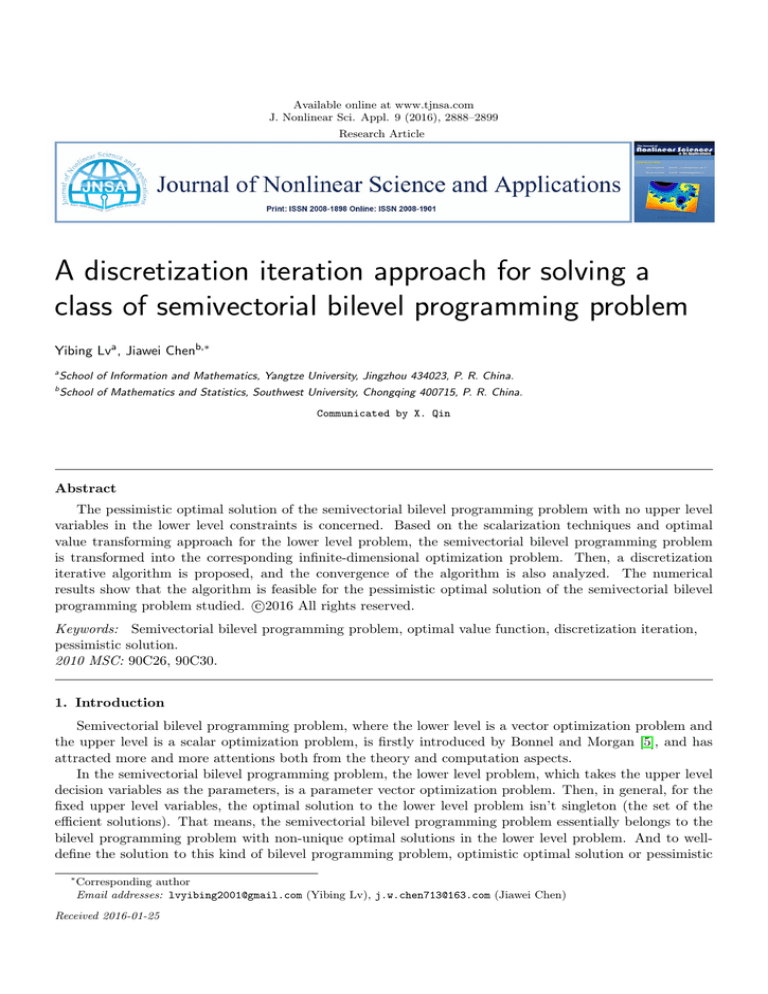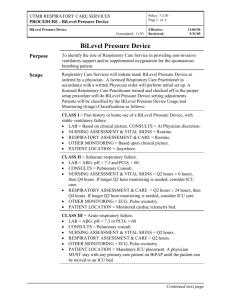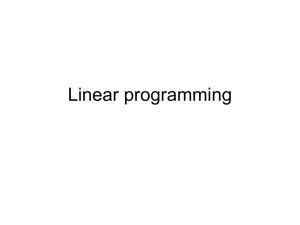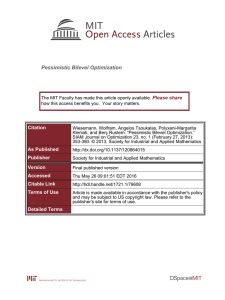
Available online at www.tjnsa.com
J. Nonlinear Sci. Appl. 9 (2016), 2888–2899
Research Article
A discretization iteration approach for solving a
class of semivectorial bilevel programming problem
Yibing Lva , Jiawei Chenb,∗
a
School of Information and Mathematics, Yangtze University, Jingzhou 434023, P. R. China.
b
School of Mathematics and Statistics, Southwest University, Chongqing 400715, P. R. China.
Communicated by X. Qin
Abstract
The pessimistic optimal solution of the semivectorial bilevel programming problem with no upper level
variables in the lower level constraints is concerned. Based on the scalarization techniques and optimal
value transforming approach for the lower level problem, the semivectorial bilevel programming problem
is transformed into the corresponding infinite-dimensional optimization problem. Then, a discretization
iterative algorithm is proposed, and the convergence of the algorithm is also analyzed. The numerical
results show that the algorithm is feasible for the pessimistic optimal solution of the semivectorial bilevel
c
programming problem studied. 2016
All rights reserved.
Keywords: Semivectorial bilevel programming problem, optimal value function, discretization iteration,
pessimistic solution.
2010 MSC: 90C26, 90C30.
1. Introduction
Semivectorial bilevel programming problem, where the lower level is a vector optimization problem and
the upper level is a scalar optimization problem, is firstly introduced by Bonnel and Morgan [5], and has
attracted more and more attentions both from the theory and computation aspects.
In the semivectorial bilevel programming problem, the lower level problem, which takes the upper level
decision variables as the parameters, is a parameter vector optimization problem. Then, in general, for the
fixed upper level variables, the optimal solution to the lower level problem isn’t singleton (the set of the
efficient solutions). That means, the semivectorial bilevel programming problem essentially belongs to the
bilevel programming problem with non-unique optimal solutions in the lower level problem. And to welldefine the solution to this kind of bilevel programming problem, optimistic optimal solution or pessimistic
∗
Corresponding author
Email addresses: lvyibing2001@gmail.com (Yibing Lv), j.w.chen713@163.com (Jiawei Chen)
Received 2016-01-25
Y. Lv, J. Chen, J. Nonlinear Sci. Appl. 9 (2016), 2888–2899
2889
optimal solution should be adopted [2, 7, 11]. In fact, many researchers have devoted to study the optimistic
or pessimistic optimal solution of the semivectorial bilevel programming problem both from the theory and
computation aspects.
For the optimistic optimal solution of the semivectorial bilevel programming problem, Bonnel and Morgan [5] construct the corresponding penalized problem in very general setting, and shows that the above
problem can be approached using penalty method. Then, Bonnel [4] and Dempe [8] respectively give the
first order necessary optimality conditions in the case where the lower level problem is a convex vector
optimization problem. Subsequently, also for such a problem, Dempe and Mehlitz [9] derive the Pontryagintype necessary optimality condition in Banach spaces. In the aspect of algorithm proposing, the researches
mainly focus on the situation that the lower level problem is a linear vector optimization problem. Ankhili
and Mansouri [1] construct the corresponding penalized problem, which takes the margin function of the
lower level problem as penalty term, then an exact penalty function algorithm is proposed. Based on the objective penalty function algorithm for the nonlinear programs, Zheng and Wan [20] propose an exact penalty
function algorithm, which contains two penalty factors, and some numerical results are reported. Based on
the optimal value function reformulation approach, Lv and Wan [16] transform this kind of semivectorial
bilevel programs into non-smooth optimization problem, and adopt the relaxing and shrinking method to
approximate the feasible region of the original programs. Then a feasible algorithm is proposed for the
optimistic optimal solution.
In the aspect of the pessimistic optimal solution of the semivectorial bilevel programming problem,
Bonnel and Morgan [6] give the existence results for the pessimistic optimal solution of the semivectorial
bilevel convex optimal control problems. For a class of semivectorial bilevel programs, where the lower level
problem is a convex vector optimization problem, Liu [13] firstly transform it into non-smooth optimization problem based on the scalarization approach. Then using the generalized differentiation calculus of
Mordukhovich, the first order necessary optimality conditions are established. For the linear semivectorial
bilevel programming problem, Lv [15] propose the exact penalty function algorithm based on the duality
approach. But few numerical results are reported in [15]. In fact, the results on the pessimistic optimal
solution of the semivectorial bilevel programming problem, whether from the theory aspect or from the
computation aspect, are very limited.
In this paper, following the line in [19] for the pessimistic bilevel optimization problem, we mainly focus
on proposing a feasible algorithm for a class of semivectorial bilevel programming problem, where the lower
level problem is a convex vector optimization problem with no upper level variables in the constraints. Our
strategy can be outlined as follows. Firstly, the semivectorial bilevel programming problem is transformed
into the bilevel single objective programming problem based on the scalarization techniques. Secondly,
using the optimal value function reformulation approach, a single level optimization problem is obtained.
After that the single level optimization problem is transformed into the corresponding infinite-dimensional
problem. Then, inspired by the discretization techniques used in the semi-infinite programs, an iterative
algorithm is proposed for the semivectorial bilevel programming problem.
The remainder of the paper is organized as follows. In the next section we present the mathematical
model of the semivectorial bilevel programming problem and give the optimal value function reformulation
approach. Then, in the following sections, we give the main results and propose the discretization iteration
algorithm. Finally, we illustrate the feasibility of the algorithm and conclude this paper.
2. Problem statement
In this paper, we consider the following semivectorial bilevel programming problem
min f (x)
x
s.t. g(x, y) ≤ 0,
min h(x, y)
y
s.t. y ∈ Y.
x ∈ X,
(2.1)
Y. Lv, J. Chen, J. Nonlinear Sci. Appl. 9 (2016), 2888–2899
2890
Where x ∈ X ⊆ Rn , y ∈ Y ⊆ Rm , and the functions f : X → R, g : X × Y → Rl , h : X × Y → Rp are all
continuous. In addition, for all x ∈ X, the function hi (x, ·)(i = 1, . . . , p) is convex. Denote by S = {(x, y) :
x ∈ X, y ∈ Y, g(x, y) ≤ 0} the constraint region of problem (2.1), and S(y) = {x ∈ X : ∃y ∈ Y, g(x, y) ≤ 0}
the projection of S onto the upper level decision space. In the following content, we make the following
assumption.
Assumption. A.1. The sets X, Y and S are compact.
For the fixed upper level variable x ∈ S(y), denote by ϕ(x) the set of the weak efficient solutions of the
lower level problem
min h(x, y)
y
(2.2)
s.t. y ∈ Y.
Then, the pessimistic semivectorial bilevel programming problem can be written as
min max f (x).
(2.3)
x∈S(y) y∈ϕ(x)
As for all x ∈ X, the function hi (x, ·)(i = 1, . . . , p) is convex, and following the corresponding results in
[10], we know that
[
ϕ(x) = ϕ(x, Ω) := {ϕ(x, λ) : λ ∈ Ω},
where Ω = {λ ∈ Rp : λ ≥ 0,
p
P
λi = 1}, and ϕ(x, λ) denotes the solution set of the following lower level
i=1
scalarization problem
min λT h(x, y)
y
s.t. y ∈ Y.
Then, problem (2.3) can be rewrite equivalently as
min
max f (x).
(2.4)
(x,λ)∈S(y)×Ω y∈ϕ(x,λ)
Go one step further, the above problem (2.4) can also be written as the following programs[19].
min f (x)
s.t.
x,λ
p
X
λi = 1,
(2.5)
i=1
T
g(x, y) ≤ 0 ∀y ∈ ϕ(x, λ) = arg min{λ h(x, z) : z ∈ Y },
z
λ ≥ 0, x ∈ X.
Remark 2.1. It is noted that the pessimistic bilevel problem (2.4) deviates slightly from the following
standard formulation (2.6) in the form of the upper level objective function, e.g., [7].
min sup f1 (x, y), where M2 (x) = arg min f2 (x, y).
x∈X y∈M2 (x)
y∈Y
(2.6)
In fact, following [14], the standard formulation (2.6) can be reformulated as an instance of problem (2.4),
min τ
x,τ
s.t. τ ≥ f1 (x, y) ∀y ∈ γ(x) = arg min{f2 (x, y) : z ∈ Y },
z
x ∈ X.
Y. Lv, J. Chen, J. Nonlinear Sci. Appl. 9 (2016), 2888–2899
2891
In problem (2.5), for the fixed upper level decisions (x, λ), the lower level scalarization problem solution
set ϕ(x, λ) can also be written as ϕ(x, λ) = {z ∈ Y : λT h(x, z) ≤ λT h(x, z 0 ), ∀z 0 ∈ Y }. Then, following the
formulations in [7, 19], the pessimistic formulation of problem (2.4) or (2.5) can be written as
min f (x),
s.t.
x,λ
p
X
λi = 1,
(2.7)
i=1
g(x, y) ≤ 0 ∀y ∈ ϕ(x, λ) = {z ∈ Y : λT h(x, z) ≤ λT h(x, z 0 ), ∀z 0 ∈ Y },
λ ≥ 0, x ∈ X.
It is known that for problem (2.7), even if the Assumption A.1 is satisfied, the feasible region of problem
(2.7) may not be closed [7], which means that problem (2.7) may not be solvable. In order to well handle
problem (2.7), in the following content we consider the -approximation of problem (2.7), that’s,
min f (x)
s.t.
x,λ
p
X
λi = 1,
(2.8)
i=1
g(x, y) ≤ 0 ∀y ∈ ϕ (x, λ) = {z ∈ Y : λT h(x, z) < λT h(x, z 0 ) + , ∀z 0 ∈ Y },
λ ≥ 0, x ∈ X,
where is some small positive parameter. In the following contents, we will focus on analyzing the characters
of the approximation problem (2.8), especially when the parameter tends to zero. After that, we will
propose a feasible algorithm for problem (2.8), and the convergence result of the algorithm proposed will
also be given.
3. Main results
The following proposition shows that the approximation problem (2.8) has a closed feasible region for
any > 0.
Proposition 3.1. For any > 0, the feasible region of problem (2.8) is closed.
Proof. Following the Tietze Extension Theorem, the function f, g, λT h are also continuous on the extended
domains f : Rn → R, g : Rn × Rm → R and λT h : Rn × Rm × Rp → R. To make the proof concise, we use
the same symbols f, g, λT h for the extended functions in the following proof.
Denote by V : Rn+p → R the function that maps the upper level decisions to the value of an optimal
lower level decision, that’s,
V (x, λ) = min λT h(x, y) for (x, λ) ∈ Rn × Rp .
y∈Y
Following the Assumption A.1 and the continuity of h, it is obvious that V (x, λ) is well defined for all
(x, λ) ∈ Rn × Rp . Based on the above function V (x, λ), the set ϕ (x, λ) can also be written as
ϕ (x, λ) = {z ∈ Y : λT h(x, z) < V (x, λ) + }.
As the sets X and Ω are both closed, the feasible region of problem (2.8) is closed if the set
χ = {(x, λ) ∈ Rn × Rp : g(x, y) ≤ 0 ∀y ∈ ϕ (x, λ)}
Y. Lv, J. Chen, J. Nonlinear Sci. Appl. 9 (2016), 2888–2899
2892
is closed. χ is closed if and only if its complement set
χ̄ = {(x, λ) ∈ Rn × Rp : g(x, y) > 0 for some y ∈ ϕ (x, λ)}
is open. To prove that χ̄ is open, we take arbitrarily an element (x̂, λ̂) ∈ χ̄ of this set and show that
(x, λ) ∈ χ̄ for all element (x, λ) in the δ-ball Bδ (x̂, λ̂), where δ > 0 is a constant that will be specified
shortly.
As (x̂, λ̂) ∈ χ̄ , there exist ŷ ∈ ϕ (x̂, λ̂) such that g(x̂, ŷ) ≥ λg for some constant λg > 0, as well as
T
λ̂ h(x̂, ŷ) ≤ V (x̂, λ̂) + − λh for some constant λh > 0. Now, we show that g(x, ŷ) > 0 and λT h(x, ŷ) <
V (x, λ) + for all (x, λ) ∈ Bδ (x̂, λ̂). Following the continuity of g, we know that there exist a constant
δg > 0, such that g(x, ŷ) > 0 for all (x, λ) ∈ Bδg (x̂, λ̂). In addition, based on the continuity of λT h(x, y), the
function V (x, λ) is also continuous. It means that the composite function (x, y, λ) → λT h(x, y) − V (x, λ)
is also continuous. Hence, there exist a constant δh > 0, such that λT h(x, ŷ) < V (x, λ) + for all (x, λ) ∈
Bδh (x̂, λ̂), that’s, ŷ ∈ ϕ (x, λ) for all (x, λ) ∈ Bδh (x̂, λ̂). Taking δ ≤ min{δg , δh }, we have (x, λ) ∈ χ̄ for all
(x, λ) ∈ Bδ (x̂, λ̂).
Based on the above Proposition 3.1, we know that problem (2.8), which is the -approximation problem
of problem (2.7), is solvable. Then, the natural question is that whether the approximation problem (2.8)
converges to the original problem (2.7) in some sense. Before this, we first give the result that the set
ϕ (x, λ) of the lower level decision in problem (2.8) converges to the set ϕ(x, λ) of the lower level decision
in problem (2.7) as the parameter → 0.
Lemma 3.2. For any (x, λ) ∈ X × Ω, the set valued mapping ϕ (x, λ) converges to ϕ(x, λ) as → 0, that’s,
∀ε > 0, ∃¯
> 0 such that dH [ϕ (x, λ), ϕ(x, λ)] ≤ ε, ∀ ∈ (0, ¯],
where dH [A, B] = sup inf ka − bk denotes the Hausdorff distance between the two sets A and B.
a∈A b∈B
Proof. For the given upper level variables x ∈ X, λ ∈ Ω, and assume to the contrary, that’s, for some ε > 0
we have
∀¯
> 0, ∃ ∈ (0, ¯] such that dH [ϕ (x, λ), ϕ(x, λ)] > ε.
For the sequence ¯k = k1 , we construct the following sequence k ∈ (0, ¯k ] and yk ∈ ϕk (x, λ) such that
kyk − yk > ε, for all y ∈ ϕ(x, λ).
As ϕk (x, λ) ⊆ Y for all k, and Y is bounded, following Bolzano-Weierstrass Theorem we can conclude that
the sequence yk has a convergent subsequence. Without loss of generality, we assume that the sequence yk
converges to y ∗ . Then, the limit point y ∗ satisfies
ky ∗ − yk ≥ ε, for all y ∈ ϕ(x, λ).
However, following the fact that Y is closed and λT h is continuous, we have
y ∗ ∈ Y and λT h(x, y ∗ ) ≤ λT h(x, y), ∀y ∈ Y.
that means, y ∗ ∈ ϕ(x, λ). And it contradicts that there exist ε > 0 such that ky ∗ − yk ≥ ε for all y ∈ ϕ(x, λ).
This contradiction verifies Lemma 3.2.
On the constraint in problem (2.8), we have the following result.
Lemma 3.3. For any x ∈ X and λ ∈ Ω, the mapping 7→ sup{g(x, y) : y ∈ ϕ (x, λ)} converges to
max{g(x, y) : y ∈ ϕ(x, λ) as → 0, that’s,
∀ε > 0 ∃¯
> 0 such that
sup
y∈ϕ (x,λ)
g(x, y) ≤ max g(x, y) + ε, ∀ ∈ (0, ¯].
y∈ϕ(x,λ)
Y. Lv, J. Chen, J. Nonlinear Sci. Appl. 9 (2016), 2888–2899
2893
Proof. For any given x ∈ X, λ ∈ Ω and ε > 0. As X and Y are compact, the function g(x, y) is uniformly
continuous in X × Y . That’s, for any y, y 0 ∈ Y , there exist δg > 0, if ky − y 0 k ≤ δg , we have
|g(x, y) − g(x, y 0 )| ≤ ε.
For the above δg , following Lemma 3.2, we have
∃¯
> 0 such that dH [ϕ (x, λ), ϕ(x, λ)] ≤ δg , ∀ ∈ (0, ¯].
Combining the above formulas, we know that there exist ¯ > 0 such that for any ∈ (0, ¯], we have
∀y ∈ ϕ (x, λ) ∃y 0 ∈ ϕ(x, λ) such that |g(x, y) − g(x, y 0 )| ≤ ε.
Following the continuity of g, Lemma 3.3 is proved.
The following result shows that the objective function value of problem (2.8) converges to that of problem
(2.7) as the parameter goes to zero. To facilitate the analysis, we denote by f the objective function value
of problem (2.8) and f the objective function value of problem (2.7).
Theorem 3.4. Let the Assumption A.1 be satisfied, and problem (2.7) has an optimal solution (x∗ , λ∗ ),
which is not a local optimal solution of the function (x, λ) 7→ max{g(x, y) : y ∈ ϕ(x, λ)} with value zero.
Then, we have
lim f = f.
→0
Proof. It’s obvious that the feasible region of problem (2.8) is a subset of that of problem (2.7). That means,
∀ > 0, we have f ≥ f . To complete the proof, we only need to prove that
∀ε > 0 ∃¯
> 0 such that f ≤ f + ε, ∀ ∈ (0, ¯].
In the following content, we prove it in three cases.
Firstly, assume that max{g(x∗ , y) : y ∈ ϕ(x, λ)} < 0, and fix some ε > 0. Then, there exist some
constant ζ > 0 such that max{g(x∗ , y) : y ∈ ϕ(x, λ)} ≤ −ζ. Following Lemma 3.3, we know that there exist
some ¯ > 0 such that
sup
g(x∗ , y) ≤ 0, ∀ ∈ (0, ¯].
y∈ϕ (x∗ ,λ∗ )
That means, for any ∈ (0, ¯], (x∗ , λ∗ ) is also a feasible solution to problem (2.8). Then, for any ∈ (0, ¯],
f = f .
Secondly, assume that max{g(x∗ , y) : y ∈ ϕ(x, λ)} = 0, and fix some ε > 0. As the objective function f is
continuous, there exist δ > 0 such that f (x) ≤ f (x∗ )+ε for any (x, λ) in the δ-ball Bδ (x∗ , λ∗ ) around (x∗ , λ∗ ).
Moreover, since (x∗ , λ∗ ) is not a local optimal solution of the function (x, λ) 7→ max{g(x, y) : y ∈ ϕ(x, λ)}
with value zero, there exist (x̂, λ̂) ∈ Bδ (x∗ , λ∗ ) such that max{g(x̂, y) : y ∈ ϕ(x, λ)} ≤ −ζ for some ζ > 0.
Following Lemma 3.3, we conclude that there exist ¯ > 0 such that
sup
g(x̂, y) ≤ 0, ∀ ∈ (0, ¯],
y∈ϕ (x̂,λ̂)
that’s, (x̂, λ̂) is feasible to problem (2.8) for all ∈ (0, ¯]. We therefore know that f ∈ [f, f + ε] for all
∈ (0, ¯]. As ε > 0 is random, the assertion follows.
Thirdly, the case max{g(x∗ , y) : y ∈ ϕ(x, λ)} > 0 can not arise.
Y. Lv, J. Chen, J. Nonlinear Sci. Appl. 9 (2016), 2888–2899
2894
Remark 3.5. In Theorem 3.4, the condition that (x∗ , λ∗ ) is not a local optimal solution of the function
(x, λ) 7→ max{g(x, y) : y ∈ ϕ(x, λ)} with value zero is just the extension of a stability condition developed
for global optimization problem, see [18].
4. Algorithm procedure
In this section, we will firstly transform problem (2.8) into the corresponding infinite-dimensional problem, and then propose a solution scheme.
Proposition 4.1. The approximation problem (2.8) is equivalent to the following infinite-dimensional problem
min f (x)
x,z,λ,µ
s.t. µ(y)[λT h(x, z) − λT h(x, y) + ] + (1 − µ(y))g(x, y) ≤ 0, ∀y ∈ Y,
p
X
(4.1)
λi = 1,
i=1
x ∈ X, λ ≥ 0, µ : Y → [0, 1],
where the function µ : Y 7→ [0, 1] is a decision variable.
Proof. By definition, the constraint g(x, y) ≤ 0 ∀y ∈ ϕ (x, λ) in problem (2.8) is equivalent to the following
semi-infinite constraint,
[y ∈ ϕ (x, λ) ⇒ g(x, y) ≤ 0] ∀y ∈ Y,
(4.2)
and the constraint (4.2) is also equivalent to the following constraint,
[y ∈
/ ϕ (x, λ)] ∨ [g(x, y) ≤ 0] ∀y ∈ Y.
(4.3)
From the definition of the set ϕ (x, λ), it can de deduced that y ∈
/ ϕ (x, λ) if and only if
∃z ∈ Y : λT h(x, y) ≥ λT h(x, z) + .
Then, the above constraint (4.3) is equivalent to the existence of z ∈ Y , such that
[λT h(x, y) ≥ λT h(x, z) + ] ∨ [g(x, y) ≤ 0] ∀y ∈ Y.
(4.4)
For a fixed lower level decision y ∈ Y , (4.4) can be rewritten as
∃µ ∈ [0, 1] : µ[λT h(x, z) − λT h(x, y) + ] + (1 − µ)g(x, y) ≤ 0.
The proposition is proved if for each lower level decision y ∈ Y , a different variable µ(y) is introduced .
For the infinite-dimensional problem (4.1), we will propose the iterative solution scheme, which is inspired
by the discretization techniques used in semi-infinite programming[3, 12]. Our solution scheme is described
in the following algorithm. The essence of the algorithm, that’s, Step 2, is that we solve a sequence of
finite-dimensional problems to approximate problem (4.1). In fact, each of these approximations constitutes
a relaxation of problem (4.1) in the sense that any feasible solution of problem (4.1) can be reduced to a
feasible solution to the problem in Step 2.
Step 3 aims to identify a constraints in problem (4.1) that can’t be satisfied. If no such constraint exists,
then the optimal solution obtained can be extended to an optimal solution of problem (4.1).
Algorithm
Step 1. Set Y0 = ∅ and k = 0.
Y. Lv, J. Chen, J. Nonlinear Sci. Appl. 9 (2016), 2888–2899
2895
Step 2. Solve the following finite-dimensional approximation of problem (4.1)
min f (x)
x,z,λ,µ
s.t. µ(yk )[λT h(x, z) − λT h(x, yk ) + ] + (1 − λ(yk ))g(x, yk ) ≤ 0, ∀yk ∈ Yk ,
p
X
(4.5)
λi = 1,
i=1
x ∈ X, λ ≥ 0, µ : Yk 7→ [0, 1].
And obtain the corresponding optimal solution (xk , zk , λk , µk ).
Step 3. Calculate the lower level objective function value λTk hk = min{λTk h(xk , z) : z ∈ Y } with (xk , λk ),
and solve the following problem
max τ
τ,y
s.t. τ ≤ λTk hk − λTk h(xk , y) + ,
τ ≤ g(xk , y),
τ ∈ R, y ∈ Y.
Obtain the optimal solution (τk , yk ).
Step 4. If τk ≤ 0, terminate, (xk , λk ) solves the approximation problem (4.1). Otherwise, set Yk+1 =
Yk ∪ {yk }, k → k + 1 and go to Step 2. The following result shows that the algorithm proposed in this
paper is correct.
Theorem 4.2. If the above algorithm terminates in Step 4 of the k-th iteration, then (xk , λk ) can be extended
to an optimal solution of problem (4.1). If the algorithm does not terminate, then the sequence {(xk , λk )}
contains accumulation points, and any accumulation point of {(xk , λk )} can also be extended to an optimal
solution of problem (4.1).
Proof.
Case 1. If the algorithm terminates in Step 4 of the k-th iteration. Following Step 3, we have
τk ≤ 0 ⇐⇒ max min{min λTk h(xk , z) − λTk h(xk , y) + , g(xk , y)} ≤ 0
y∈Y
z∈Y
⇐⇒ max min {µ[min λTk h(xk , z) − λTk h(xk , y) + ] + (1 − µ)g(xk , y)} ≤ 0.
y∈Y µ∈[0,1]
z∈Y
By construction, the last inequality is equivalent to
∃µ : Y 7→ [0, 1] : µ(y)[min λTk h(xk , z) − λTk h(xk , y) + ] + (1 − µ(y))g(xk , y) ≤ 0 ∀y ∈ Y,
z∈Y
that is, (xk , λk ) can be extended to a feasible solution (xk , z, λk , µ) to problem (4.1) if we choose
z ∈ arg min{λTk h(xk , y) : y ∈ Y }. Since any feasible point of problem (4.5) is also feasible to problem
(4.1), and the both problems have the same objective function, it shows that the solution (xk , z, λk , µ)
solves problem (4.1).
Case 2. If the algorithm does not terminate. Since the sets X, Y and Ω are bounded. We can apply
the Bolzano-Weierstrass Theorem to conclude that the sequence {(xk , yk , λk )} generated by the above
Y. Lv, J. Chen, J. Nonlinear Sci. Appl. 9 (2016), 2888–2899
2896
algorithm contains accumulation points. Without losing generality, we can assume that the sequence
{(xk , yk , λk )} converges to (x∗ , y ∗ , λ∗ ). Since the sets X, Y and Ω are closed, we have x∗ ∈ X, y ∗ ∈ Y
and λ∗ ∈ Ω. Now, we will show that (x∗ , λ∗ ) can be extended to a feasible solution (x∗ , z, λ∗ , µ) to
problem (4.1).
Take z ∈ arg min{(λ∗ )T h(x∗ , y) : y ∈ Y }, we will show that there exist a function µ : Y 7→ [0, 1] such
that
µ(y)[min(λ∗ )T h(x∗ , z) − (λ∗ )T h(x∗ , y) + ] + (1 − µ(y))g(x∗ , y) ≤ 0, ∀y ∈ Y.
z∈Y
Assume to the contrary that there exist ŷ ∈ Y such that
µ[min(λ∗ )T h(x∗ , z) − (λ∗ )T h(x∗ , ŷ) + ] + (1 − µ)g(x∗ , ŷ) ≥ δ
z∈Y
for all µ ∈ [0, 1] and some δ > 0. As the functions g and λT h are continuous, for sufficiently large k
we have
µ[min λTk h(xk , z) − λTk h(xk , ŷ) + ] + (1 − µ)g(xk , ŷ) ≥ δ 0
z∈Y
for all µ ∈ [0, 1] and some δ 0 > 0. Following Step 3 in the above algorithm, we have
min{min λTk h(xk , z) − λTk h(xk , yk ) + , g(xk , yk )} ≥ min{min λTk h(xk , z) − λTk h(xk , ŷ) + , g(xk , ŷ)},
z∈Y
z∈Y
that means,
µ[min λTk h(xk , z) − λTk h(xk , yk ) + ] + (1 − µ)g(xk , yk ) ≥ δ 0
z∈Y
for all µ ∈ [0, 1]. When k → ∞, we have
µ[min(λ∗ )T h(x∗ , z) − (λ∗ )T h(x∗ , y ∗ ) + ] + (1 − µ)g(x∗ , y ∗ ) ≥ δ 0
z∈Y
for all µ ∈ [0, 1]. However, in problem (4.5), there exist µ ∈ [0, 1] such that
µ[min λTk+1 h(xk+1 , z) − λTk+1 h(xk+1 , yk ) + ] + (1 − µ)g(xk+1 , yk ) ≤ 0
z∈Y
in the k + 1-th iteration of the algorithm. Taking k → ∞, we have
µ[min(λ∗ )T h(x∗ , z) − (λ∗ )T h(x∗ , y ∗ ) + ] + (1 − µ)g(x∗ , y ∗ ) ≤ 0
z∈Y
for some µ ∈ [0, 1]. Since the sequence {(xk+1 , λk+1 )} converges to (x∗ , λ∗ ). This yields a contradiction,
and we conclude that there exist a function µ : Y 7→ [0, 1] such that
µ(y)[min(λ∗ )T h(x∗ , z) − (λ∗ )T h(x∗ , y) + ] + (1 − µ(y))g(x∗ , y) ≤ 0, ∀y ∈ Y.
z∈Y
that is, (x∗ , λ∗ ) can indeed be extended to a feasible solution (x∗ , z, λ∗ , µ) to problem (4.1). Following
the same reason in Case 1, we can conclude that (x∗ , z, λ∗ , µ) solves problem (4.1).
5. Numerical Results
To verify the feasibility of the proposed algorithm, we will consider it to solve some semivectorial bilevel
programming problems with no upper level variables in the lower level constraints. Firstly, we consider the
following bilevel programming problems with single objective in the lower level, which comes from [17].
Y. Lv, J. Chen, J. Nonlinear Sci. Appl. 9 (2016), 2888–2899
2897
Example 5.1.
1
min max (x − )2 + y 2
x y∈ϕ(x)
4
s.t. x ∈ [−1, 1],
(5.1)
where ϕ(x) = argmin{
z∈[0,1]
z3
3
− xz}.
For the fixed upper level decision variable x, the set of optimal lower level decisions is given by
0 if −1 ≤ x ≤ 0,
ϕ(x) = √
x if 0 < x ≤ 1.
It is obvious that problem (5.1) has the same optimistic and pessimistic optimal solution (x, y) = ( 14 , 12 )
with an objective value of 41 . And the pessimistic optimal solution of the perturbed problem (5.1) with the
q
small positive parameter is (x, y) = ( 41 + , 14 + ), resulting in an objective value of 14 + + 2 .
Example 5.2.
1
min max (x − )2 + y 2
x y∈ϕ(x)
4
s.t. x ∈ [−1, 1],
(5.2)
where ϕ(x) = argmin{
z∈[0,1]
z3
3
− x2 z}.
For the fixed upper level decision variable x, the set of optimal lower level decisions is given by
−x if −1 ≤ x ≤ 0,
ϕ(x) =
x if 0 < x ≤ 1.
Problem (5.2) has also the same optimistic and pessimistic optimal solution (x, y) = ( 12 , 21 ) with an objective
5
value of 16
.
And the pessimistic optimal solution of the perturbed problem (5.2) with the small positive parameter
5
is (x, y) = ( 12 + , 12 + ), resulting in an objective value of 16
+ 23 + 22 .
Based on the above two examples, we construct the following two semivectorial bilevel programming
problems with no upper level variables in the lower level constraints.
Example 5.3.
1
min max (x − )2 + y 2
x y∈ϕ(x)
4
s.t. x ∈ [−1, 1],
(5.3)
where ϕ(x) = argmin{
z∈[0,1]
z3
3
− xz,
2z 3
3
− 2xz}T .
Example 5.4.
1
min max (x − )2 + y 2
x y∈ϕ(x)
4
s.t. x ∈ [−1, 1],
(5.4)
where ϕ(x) = argmin{
z∈[0,1]
z3
3
− x2 z,
2z 3
3
− 2x2 z}T .
Remark 5.5. In the above Example 5.3 and Example 5.4, the objective functions in the lower level are
consistent, then the perturbed problem (5.3) and problem (5.4) should have the same pessimistic optimal
solutions with that of the perturbed problem (5.1) and problem (5.2), respectively.
Y. Lv, J. Chen, J. Nonlinear Sci. Appl. 9 (2016), 2888–2899
2898
In the following, we apply the algorithm proposed in this paper to solve the above problem (5.3) and
problem (5.4), and all the problems involved are solved to optimality using Matlab 2014b. The numerical
results are listed in Table 1.
Table 1: Pessimistic optimal solutions of Example 5.3 and Example 5.4
Exam. 5.3
Exam. 5.4
objective
0.25067
0.31350
x
0.25067
0.50067
y
0.50067
0.50067
0.001
0.001
iterations
4
4
Comparing the results in Table 1 with that of Examples 5.1 and 5.2, we can find that the algorithm
proposed in this paper is feasible for the pessimistic optimal solution of the semivectorial bilevel programming
problem studied.
6. Conclusions
In this paper, we propose a discretization iterative algorithm for the pessimistic optimal solution of
a class of semivectorial bilevel programming problem, where the lower level problem is a convex vector
optimization problem with no upper level variable in the constraints. The numerical results show that the
algorithm proposed is feasible for the pessimistic optimal solution of the semivectorial bilevel programming
problem studied. It is noted that no upper level variable in the lower level constraints is essential for both
the formulation and the solution of the approximate problems.
It is well known that pessimistic optimal solution for the bilevel programming problem is a rather tough
task by now. Whether and how the approach presented in this paper can be extended to the more general
situation that the lower level constraints contain the upper level variables will be our future work.
Acknowledgements
The authors would like to express their thanks to the associated editor and the two anonymous referees
for their valuable comments and suggestions to improve the previous version of this paper. This work is
supported by the National Natural Science Foundation of China (11201039,11401487,71171150) and the
Fundamental Research Funds for the Central Universities (XDJK2014C073).
References
[1] Z. Ankhili, A. Mansouri, An exact penalty on bilevel programs with linear vector optimization lower level, European
J. Oper. Res., 197 (2009), 36–41. 1
[2] J. F. Bard, Practical Bilevel Optimization: Algorithm and Applications, Nonconvex Optim. Appl., Kluwer, Dordrecht, (1998). 1
[3] J. W. Blankenship, J. E. Falk, Infinitely constrained optimization problems, J. Optim. Theory Appl., 19 (1976),
261–281. 4
[4] H. Bonnel, Optimality conditions for the semivectorial bilevel optimization problem, Pac. J. Optim., 2 (2006),
447–467. 1
[5] H. Bonnel, J. Morgan, Semivectorial bilevel optimization problem: Penalty approach, J. Optim. Theory Appl.,
131 (2006), 365–382. 1
[6] H. Bonnel, J. Morgan, Semivectorial bilevel convex optimal control problems: existence results, SIAM J. Control
Optim., 50 (2012), 3224–3241. 1
[7] S. Dempe, Foundations of Bilevel Programming, Nonconvex Optim. Appl., Kluwer, Dordrecht, (2002).1, 2.1, 2.1,
2.1
[8] S. Dempe, N. Gadhi, A. B. Zemkoho, New optimality conditions for the semivectorial bilevel optimization problem,
J. Optim. Theory Appl., 157 (2013), 54–74. 1
[9] S. Dempe, P. Mehlitz, A remark on semivectorial bilevel programming and an application in semivectorial bilevel
optimal control, Math. Inform., (preprint), (2014). 1
[10] M. Ehrgott, Multicriteria Optimization, Springer, Berlin, (2005). 2
[11] G. Eichfelder, Multiobjective bilevel optimization, Math. Program., 123 (2010), 419–449. 1
Y. Lv, J. Chen, J. Nonlinear Sci. Appl. 9 (2016), 2888–2899
2899
[12] R. Hettich, K. O. Kortanek, Semi-infinite programming: theory, methods and applications, SIAM Rev., 35 (1993),
380–429. 4
[13] B. Liu, Z. Wan, J. Chen, G. Wang, Optimality conditions for pessimistic semivectorial bilevel programming
problems, J. Inequal. Appl., 2014 (2014), 26 pages. 1
[14] P. Loridan, J. Morgan, Weak via strong Stackelberg problem: new results, Hierarchical and bilevel programming,
J. Global Optim., 8 (1996), 263–287. 2.1
[15] Y. Lü, Z. M. Hong, Z. P. Wan, A penalty function method for solving a class of weak linear bilevel multi-objective
programming problem (Chinese), J. Math. (Wuhan), 33 (2013), 465–472. 1
[16] Y. Lv, Z. Wan, A solution method for the optimistic linear semivectorial bilevel optimization problem, J. Inequal.
Appl., 2014 (2014), 10 pages. 1
[17] A. Mitsos, P. I. Barton, A test set for bilevel programs, Technical report, Massachusetts Institute of Technology,
(2006). 5
[18] H. Tuy, Convex programs with an additional reverse convex constraint, J. Optim. Theory Appl., 52 (1987),
463–486. 3.5
[19] W. Wiesemann, A. Tsoukalas, P. M. Kleniati, B. Rustem, Pessimistic bilevel optimization, SIAM J. Optim., 23
(2013), 353–380. 1, 2, 2.1
[20] Y. Zheng, Z. Wan, A solution method for semivectorial bilevel programming problem via penalty method, J. Appl.
Math. Comput., 37 (2011), 207–219. 1







![[Click here are type Paper Title]](http://s3.studylib.net/store/data/007470772_1-3a8664f085e8440642bf3f9875e80d05-300x300.png)
